

Spurge is a truly unique plant, both for its flowers and leaves.
Summary of Spurge facts
Name – Euphorbia
Family – Euphorbiaceae
Type – perennial
Height – 6 to 8 inches (40 to 120 cm)
Exposure – full sun, part sun
Soil – ordinary
Flowering – spring, early summer
Foliage – evergreen or deciduous depending on the area
It is surprising in spring for its out-of-this-world blooming. During the rest of the year, evergreen varieties are unique, too.
Planting spurge is best in fall to favor root development before winter and thus growing back in spring.
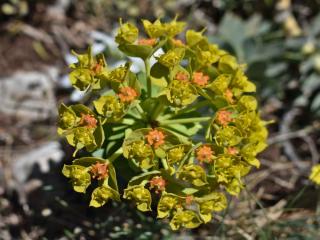 You can also plant it up to spring but avoid frost spells. If you’re planting in spring, you’ll need to remember to water more often over the 1st year.
You can also plant it up to spring but avoid frost spells. If you’re planting in spring, you’ll need to remember to water more often over the 1st year.
Here are a few interesting and distinctive varieties.
Spurge varieties and recommended exposure
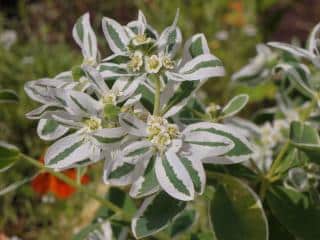 For dry, sunny locations, best plant Euphorbia characias or Euphorbia ‘Blackord’.
For dry, sunny locations, best plant Euphorbia characias or Euphorbia ‘Blackord’.
In places of light shade, prefer Euphorbia palustris or Marsh spurge, it loves cool ground.
If you know that it freezes during winter, even simple frost spells, Euphorbia griffithii can survive temperatures as cold as 5°F (-15°C).
Lastly, if easy care is important, go for Euphorbia amygdaloides var Robbiae.
Did you know the world-famous Poinsettia is a type of spurge?
It is perfectly possible to grow your spurges in a pot. It’s even a brilliant idea for your decks, patios and balconies.
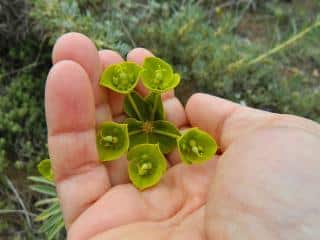 Once it has settled in properly, spurge is considered an easy-going plant that only requires little care.
Once it has settled in properly, spurge is considered an easy-going plant that only requires little care.
Detach flowers once they’ve wilted away, and protect your hands from sap because it will cause skin rashes.
Spurges don’t like being moved to different places, so try to think of the best place right off the bat when planting.
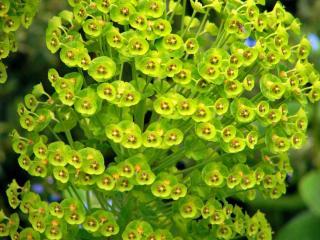 Spurge is a unique, original and cute perennial. It is subdivided into a great number of species: over 2300 have been accounted to this day. Practically the only thing they share in common is the sap which is highly irritant and poisonous.
Spurge is a unique, original and cute perennial. It is subdivided into a great number of species: over 2300 have been accounted to this day. Practically the only thing they share in common is the sap which is highly irritant and poisonous.
The plant can be a perennial, an annual, a biennial and sometimes grows as big as a shrub.
It needs just the right climate to keep its leaves for all 4 seasons of the year.
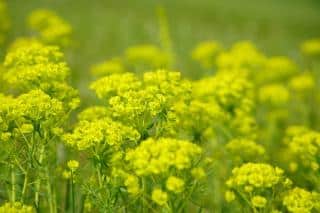 It grows a lot, and quickly, which makes it adequate for ground cover.
It grows a lot, and quickly, which makes it adequate for ground cover.
If the acid green color of the plant surprises you in spring, you won’t be disappointed: all year long, this plant is remarkable whenever leaves can last that long.
Read also:
The flowers can be used in bouquets, they are very ornamental.
Whenever you must handle the plant, wear gloves because all parts of the plant are poisonous.
We have blackbird spurge very beautiful coloration. It’s drying up in the fall. The other one dried up in summer. Still looks good from a distance so we’re leaving it up. Is it natural for spurge to dry up. What should we do next?
Hello Albert, well honestly it’s a bit surprising that your spurge would be drying up, especially in summer. In a frost-bitten area I wouldn’t be surprised to see the top die off, leaving the root system intact for the plant to grow back in spring, but in summer I think it may have needed more watering.
Although it has thick, fleshy leaves, blackbird spurge isn’t a cactus and it needs water around once a week. Maybe your plants got thirsty?
Perhaps it’s also only the flower stems that are drying up; this, on the other hand, is perfectly normal.
If you’re afraid of losing your blackbird, you can try to prepare cuttings: snip a short piece 1½ inches (4 cm) off the tip of a stem, place it to root in moist potting soil mix with a plastic covering to keep very high air moisture (above 90% relative humidity), mist from time to time. You’re not legally allowed to sell or give these cuttings away since this variety is patent pending, but recovering a plant from one that’s dying for yourself is ok.